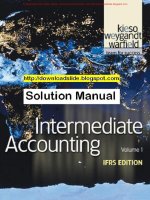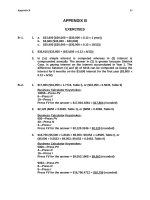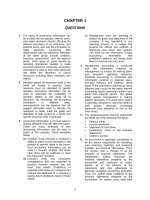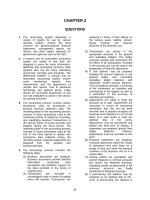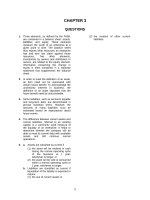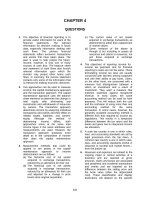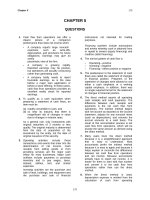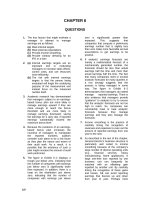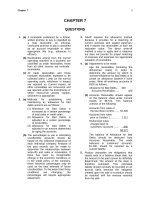Solution manual intermediate accounting 7th by nelson spiceland ch05
Bạn đang xem bản rút gọn của tài liệu. Xem và tải ngay bản đầy đủ của tài liệu tại đây (632.87 KB, 81 trang )
Find more slides, ebooks, solution manual and testbank on www.downloadslide.com
Chapter 5
Income Measurement and Profitability Analysis
QUESTIONS FOR REVIEW OF KEY TOPICS
Question 5-1
The realization principle requires that two criteria be satisfied before revenue can be
recognized:
1. The earnings process is judged to be complete or virtually complete.
2. There is reasonable certainty as to the collectibility of the asset to be received (usually
cash).
Question 5-2
At the time production is completed, there usually exists significant uncertainty as to the
collectibility of the asset to be received. We don’t know if the product will be sold, nor the selling
price, nor the buyer if eventually the product is sold. Because of these uncertainties, revenue
recognition usually is delayed until the point of product delivery.
Question 5-3
If the installment sale creates a situation where there is significant uncertainty concerning cash
collection and it is not possible to make an accurate assessment of future bad debts, revenue and cost
recognition should be delayed beyond the point of delivery.
Question 5-4
The installment sales method recognizes gross profit by applying the gross profit percentage on
the sale to the amount of cash actually received each period. The cost recovery method defers all
gross profit recognition until cash has been received equal to the cost of the item sold.
Question 5-5
Deferred gross profit is a contra installment receivable account. The balance in this account is
subtracted from gross installment receivables to arrive at installment receivables, net. The net
amount of the receivables represents the portion of remaining payments that represent cost recovery.
Question 5-6
Because the return of merchandise can retroactively negate the benefits of having made a sale,
the seller must meet certain criteria before revenue is recognized in situations when the right of
return exists. The most critical of these criteria is that the seller must be able to make reliable
estimates of future returns. In certain situations, these criteria are not satisfied at the point of delivery
of the product.
Solutions Manual, Vol.1, Chapter 5
© The McGraw-Hill Companies, Inc., 2007
5-1
Find more slides, ebooks, solution manual and testbank on www.downloadslide.com
Answers to Questions (continued)
Question 5-7
Sometimes a company arranges for another company to sell its product under consignment.
The “consignor” physically transfers the goods to the other company (the consignee), but the
consignor retains legal title. If the consignee can’t find a buyer within an agreed-upon time, the
consignee returns the goods to the consignor. However, if a buyer is found, the consignee remits the
selling price (less commission and approved expenses) to the consignor.
Because the consignor retains the risks and rewards of ownership of the product and title does
not pass to the consignee, the consignor does not record revenue (and related costs) until the
consignee sells the goods and title passes to the eventual customer.
Question 5-8
For service revenue, if there is one final service that is critical to the earnings process, revenues and
costs are deferred and recognized after this service has been performed. On the other hand, in many
instances, service revenue activities occur over extended periods and recognizing revenue at any
single date within that period would be inappropriate. Instead, it’s more meaningful to recognize
revenue over time in proportion to the performance of the activity.
Question 5-9
The completed contract method of recognizing revenues and costs on long-term construction
contracts is equivalent to recognizing revenue at point of delivery, i.e., when the construction project
is complete. The percentage-of-completion method assigns a fair share of the project’s expected
revenues and costs to each period in which the earnings process takes place, i.e., the construction
period. The “fair share” means the project's costs incurred each period as a percentage of the
project's total estimated costs. The completed contract method should only be used when the lack of
dependable estimates or inherent hazards cause forecasts of future costs to be doubtful.
Question 5-10
The billings on construction contract account is a contra account to the asset, construction in
progress. At the end of each reporting period, the balances in these two accounts are compared. If
the net amount is a debit, it is reported on the balance sheet as an asset. Conversely, if the net
amount is a credit, it is reported as a liability.
Question 5-11
An estimated loss on a long-term contract must be fully recognized in the first period the loss is
anticipated, regardless of the revenue recognition method used.
Question 5-12
These SOP’s require that if an arrangement includes multiple elements, the revenue from the
arrangement should be allocated to the various elements based on the relative fair values of the
individual elements, “regardless of any separate prices stated within the contract for each element.”
© The McGraw-Hill Companies, Inc., 2007
5-2
Intermediate Accounting, 4/e
Find more slides, ebooks, solution manual and testbank on www.downloadslide.com
Answers to Questions (continued)
Question 5-13
Specific guidelines for revenue recognition of the initial franchise fee are provided by SFAS
45. A key to these guidelines is the concept of substantial performance. It requires that
substantially all of the initial services of the franchisor required by the franchise agreement be
performed before the initial franchise fee can be recognized as revenue. The term “substantial”
requires professional judgment on the part of the accountant. In situations when the initial franchise
fee is collectible in installments, even after substantial performance has occurred, the installment
sales or cost recovery method should be used for profit recognition, if a reasonable estimate of
uncollectibility cannot be made.
Question 5-14
Receivables turnover ratio
=
Net sales
Average accounts receivable (net)
Inventory turnover ratio
=
Cost of goods sold
Average inventory
Asset turnover ratio
=
Net sales
Average total assets
Activity ratios are designed to provide information about a company’s effectiveness in
managing assets. Activity or turnover of certain assets measures the frequency with which those
assets are replaced. The greater the number of times an asset turns over, the less cash a company
must devote to that asset, and the more cash it can commit to other purposes.
Solutions Manual, Vol.1, Chapter 5
© The McGraw-Hill Companies, Inc., 2007
5-3
Find more slides, ebooks, solution manual and testbank on www.downloadslide.com
Answers to Questions (concluded)
Question 5-15
Profit margin on sales
=
Net income
Net sales
Return on assets
=
Net income
Average total assets
Return on shareholders'
equity
=
Net income
Average shareholders' equity
A fundamental element of an analyst’s task is to develop an understanding of a firm’s
profitability. Profitability ratios provide information about a company’s ability to earn an adequate
return relative to sales or resources devoted to operations. Resources devoted to operations can be
defined as total assets or only those assets provided by owners, depending on the evaluation
objective.
Question 5-16
These perspectives are referred to as the discrete and integral part approaches. Current interim
reporting requirements and existing practice generally view interim reports as integral parts of
annual statements. However, the discrete approach is applied to some items. Most revenues and
expenses are recognized in interim periods as incurred. However, if an expenditure clearly benefits
more than just the period in which it is incurred, the expense should be spread among the periods
benefited. Examples include annual repair expenses, property tax expense, and advertising expenses
incurred in one quarter that clearly benefit later quarters. These are assigned to each quarter through
the use of accruals and deferrals. On the other hand, major events such as discontinued operations,
extraordinary items, and unusual or infrequent items should be reported separately in the interim
period in which they occur.
© The McGraw-Hill Companies, Inc., 2007
5-4
Intermediate Accounting, 4/e
Find more slides, ebooks, solution manual and testbank on www.downloadslide.com
BRIEF EXERCISES
Brief Exercise 5-1
2006 gross profit = $3,000,000 – 1,200,000 = $1,800,000
2007 gross profit = 0
Brief Exercise 5-2
2006 Cost recovery % :
$1,200,000
= 40% (gross profit % = 60%)
$3,000,000
2006 gross profit = 2006 cash collection of $150,000 x 60% = $90,000
2007 gross profit = 2007 cash collection of $150,000 x 60% = $90,000
Brief Exercise 5-3
No gross profit will be recognized in either 2006 or 2007. Gross profit will not
be recognized until the entire $1,200,000 cost of the land is recovered. In this case,
gross profit recognition will equal 100% of the cash collected beginning with the ninth
installment payment ($1,200,000 ÷ $150,000 = 8 payments to recover the cost of the
land).
Brief Exercise 5-4
Initial deferred gross profit ($3,000,000 – 1,200,000)
Less gross profit recognized in 2006 ($150,000 x 60%)
Less gross profit recognized in 2007 ($150,000 x 60%)
Deferred gross profit at the end of 2007
Solutions Manual, Vol.1, Chapter 5
$1,800,000
(90,000)
(90,000)
$1,620,000
© The McGraw-Hill Companies, Inc., 2007
5-5
Find more slides, ebooks, solution manual and testbank on www.downloadslide.com
Brief Exercise 5-5
The seller must meet certain criteria before revenue can be recognized in
situations when the right of return exists. The most critical of these criteria is that the
seller must be able to make reliable estimates of future returns. If Meyer’s
management can make reliable estimates of the furniture that will be returned, revenue
can be recognized when the product is delivered, assuming the company has no
additional obligations to the buyer. If reliable estimates cannot be made because of
significant uncertainty, revenue and related cost recognition is delayed until the
uncertainty is resolved.
Brief Exercise 5-6
% of completion = $6 million ÷ $15 million = 40%
Total estimated gross profit ($20 million – 15 million) =
multiplied by the % of completion
Gross profit recognized the first year
$5,000,000
40%
$2,000,000
First year revenue = $20,000,000 x 40% = $8,000,000
Brief Exercise 5-7
Assets:
Accounts receivable ($7 million – 5 million)
Cost plus profit ($6 million + $2 million*)
in excess of billings ($7 million)
* Total estimated gross profit ($20 million – 15 million) =
multiplied by the % of completion
Gross profit recognized in the first year
$2,000,000
1,000,000
$5,000,000
40%
$2,000,000
Brief Exercise 5-8
© The McGraw-Hill Companies, Inc., 2007
5-6
Intermediate Accounting, 4/e
Find more slides, ebooks, solution manual and testbank on www.downloadslide.com
Year 1 = 0
Year 2 = $4 million
Revenue
Less: Costs in year 1
Costs in year 2
Actual profit
$20,000,000
(6,000,000)
(10,000,000)
$ 4,000,000
Brief Exercise 5-9
The anticipated loss of $3 million ($30 million contract price less total estimated
costs of $33 million) must be recognized in the first year applying either method.
Brief Exercise 5-10
Specific conditions for revenue recognition of the initial franchise fee are
provided by SFAS 45. A key to these conditions is the concept of substantial
performance. It requires that substantially all of the initial services of the franchisor
required by the franchise agreement be performed before the initial franchise fee can
be recognized as revenue. The term “substantial” requires professional judgment on
the part of the accountant. Often, substantial performance is considered to have
occurred when the franchise opens for business.
Continuing franchise fees are recognized over time as the services are performed.
Brief Exercise 5-11
Receivables turnover ratio
=
Solutions Manual, Vol.1, Chapter 5
Receivables turnover ratio
Net sales
© The McGraw-Hill
Companies,
Average accounts
receivable
(net) Inc., 2007
5-7
=
$600,000
[$100,000 + 120,000] ÷ 2
Find more slides, ebooks, solution manual and testbank on www.downloadslide.com
Inventory turnover ratio
Inventory turnover ratio
=
Cost of goods sold
Average inventory
=
$400,000*
[$80,000 + 60,000] ÷ 2
=
5.71 times
*$600,000 – 200,000
© The McGraw-Hill Companies, Inc., 2007
5-8
Intermediate Accounting, 4/e
Find more slides, ebooks, solution manual and testbank on www.downloadslide.com
Brief Exercise 5-12
Profit margin
Return on assets
Return on shareholders’
equity
=
Net income
Sales
=
$65,000
$420,000
=
15.5%
=
Net income
Average total assets
=
$65,000
$800,000
=
8.1%
=
Net income
Average shareholders’ equity
=
$65,000
$522,500*
=
12.4%
Shareholders’ equity, beginning of period
Add: Net income
Deduct: Dividends
Shareholders’ equity, end of period
$500,000
65,000
(20,000)
$545,000
*Average shareholders equity = ($500,000 + 545,000) ÷ 2 = $522,500
Solutions Manual, Vol.1, Chapter 5
© The McGraw-Hill Companies, Inc., 2007
5-9
Find more slides, ebooks, solution manual and testbank on www.downloadslide.com
Brief Exercise 5-13
Inventory turnover ratio = Cost of goods sold ÷ Average inventory
6.0
=
x
÷
$75,000
Cost of goods sold
= $75,000 x 6.0 = $450,000
Sales
$600,000
- Cost of goods sold = Gross profit
$450,000
= $150,000
© The McGraw-Hill Companies, Inc., 2007
5-10
Intermediate Accounting, 4/e
Find more slides, ebooks, solution manual and testbank on www.downloadslide.com
EXERCISES
Exercise 5-1
Requirement 1
2006 Cost recovery %:
$234,000
= 65% (gross profit % = 35%)
$360,000
2007 Cost recovery %:
$245,000
= 70% (gross profit % = 30%)
$350,000
2006 gross profit:
Cash collection from 2006 sales of $150,000 x 35% =
$52,500
2007 gross profit:
Cash collection from 2006 sales of $100,000 x 35% =
+ Cash collection from 2007 sales of $120,000 x 30% =
Total 2007 gross profit
$ 35,000
36,000
$71,000
Requirement 2
2006 deferred gross profit balance:
2006 initial gross profit ($360,000 - 234,000)
Less: Gross profit recognized in 2006
Balance in deferred gross profit account
$126,000
(52,500)
$73,500
2007 deferred gross profit balance:
2006 initial gross profit ($360,000 - 234,000)
Less: Gross profit recognized in 2006
Gross profit recognized in 2007
$ 126,000
(52,500)
(35,000)
2007 initial gross profit ($350,000 - 245,000)
Less: Gross profit recognized in 2007
Balance in deferred gross profit account
105,000
(36,000)
$107,500
Solutions Manual, Vol.1, Chapter 5
© The McGraw-Hill Companies, Inc., 2007
5-11
Find more slides, ebooks, solution manual and testbank on www.downloadslide.com
Exercise 5-2
2006
To record installment sales
Installment receivables .................................................. 360,000
Inventory ...................................................................
234,000
Deferred gross profit .................................................
126,000
2006
To record cash collections from installment sales
Cash .............................................................................. 150,000
Installment receivables ..............................................
150,000
2006
To recognize gross profit from installment sales
Deferred gross profit ..................................................... 52,500
Realized gross profit..................................................
52,500
2007
To record installment sales
Installment receivables .................................................. 350,000
Inventory ...................................................................
245,000
Deferred gross profit .................................................
105,000
2007
To record cash collections from installment sales
Cash .............................................................................. 220,000
Installment receivables ..............................................
220,000
2007
To recognize gross profit from installment sales
Deferred gross profit ..................................................... 71,000
Realized gross profit..................................................
71,000
© The McGraw-Hill Companies, Inc., 2007
5-12
Intermediate Accounting, 4/e
Find more slides, ebooks, solution manual and testbank on www.downloadslide.com
Exercise 5-3
Requirement 1
Year
2006
2007
2008
2009
Total
Income recognized
$180,000 ($300,000 - 120,000)
-0-0-0$180,000
Requirement 2
Year
2006
2007
2008
2009
Totals
Cash Collected
$ 75,000
75,000
75,000
75,000
$300,000
Cost Recovery(40%)
$ 30,000
30,000
30,000
30,000
$120,000
Gross Profit(60%)
$ 45,000
45,000
45,000
45,000
$180,000
Cost Recovery
$ 75,000
45,000
-0-0$120,000
Gross Profit
-0$ 30,000
75,000
75,000
$180,000
Requirement 3
Year
2006
2007
2008
2009
Totals
Cash Collected
$ 75,000
75,000
75,000
75,000
$300,000
Solutions Manual, Vol.1, Chapter 5
© The McGraw-Hill Companies, Inc., 2007
5-13
Find more slides, ebooks, solution manual and testbank on www.downloadslide.com
Exercise 5-4
Requirement 1
July 1, 2006
To record installment sale
Installment receivables .................................................. 300,000
Sales revenue.............................................................
300,000
Cost of goods sold......................................................... 120,000
Inventory ...................................................................
120,000
To record cash collection from installment sale
Cash .............................................................................. 75,000
Installment receivables ..............................................
75,000
July 1, 2007
To record cash collection from installment sale
Cash .............................................................................. 75,000
Installment receivables ..............................................
75,000
© The McGraw-Hill Companies, Inc., 2007
5-14
Intermediate Accounting, 4/e
Find more slides, ebooks, solution manual and testbank on www.downloadslide.com
Exercise 5-4 (continued)
Requirement 2
July 1, 2006
To record installment sale
Installment receivables .................................................. 300,000
Inventory ...................................................................
120,000
Deferred gross profit .................................................
180,000
To record cash collection from installment sale
Cash .............................................................................. 75,000
Installment receivables ..............................................
75,000
To recognize gross profit from installment sale
Deferred gross profit ..................................................... 45,000
Realized gross profit..................................................
45,000
July 1, 2007
To record cash collection from installment sale
Cash .............................................................................. 75,000
Installment receivables ..............................................
75,000
To recognize gross profit from installment sale
Deferred gross profit ..................................................... 45,000
Realized gross profit..................................................
45,000
Solutions Manual, Vol.1, Chapter 5
© The McGraw-Hill Companies, Inc., 2007
5-15
Find more slides, ebooks, solution manual and testbank on www.downloadslide.com
Exercise 5-4 (concluded)
Requirement 3
July 1, 2006
To record installment sale
Installment receivables .................................................. 300,000
Inventory ...................................................................
120,000
Deferred gross profit .................................................
180,000
To record cash collection from installment sale
Cash .............................................................................. 75,000
Installment receivables ..............................................
75,000
July 1, 2007
To record cash collection from installment sale
Cash .............................................................................. 75,000
Installment receivables ..............................................
75,000
To recognize gross profit from installment sale
Deferred gross profit ..................................................... 30,000
Realized gross profit..................................................
30,000
Exercise 5-5
Requirement 1
Cost of goods sold ($1,000,000 - 600,000)
Add: Gross profit if use cost recovery method
Cash collected
$400,000
100,000
$500,000
Requirement 2
$ 600,000
Gross profit percentage =
= 60%
$1,000,000
Cash collected x Gross profit percentage = Gross profit recognized
$500,000 x 60% = $300,000 gross profit
© The McGraw-Hill Companies, Inc., 2007
5-16
Intermediate Accounting, 4/e
Find more slides, ebooks, solution manual and testbank on www.downloadslide.com
Exercise 5-6
Requirement 1
April 1, 2006
To record installment sale
Installment receivables .................................................. 2,400,000
Land ..........................................................................
480,000
Gain on sale of land...................................................
1,920,000
April 1, 2006
To record cash collection from installment sale
Cash .............................................................................. 120,000
Installment receivables ..............................................
120,000
April 1, 2007
To record cash collection from installment sale
Cash .............................................................................. 120,000
Installment receivables ..............................................
120,000
Solutions Manual, Vol.1, Chapter 5
© The McGraw-Hill Companies, Inc., 2007
5-17
Find more slides, ebooks, solution manual and testbank on www.downloadslide.com
Exercise 5-6 (concluded)
Requirement 2
April 1, 2006
To record installment sale
Installment receivables .................................................. 2,400,000
Land ..........................................................................
480,000
Deferred gain.............................................................
1,920,000
When payments are received, gain on sale of land is recognized, calculated by
applying the gross profit percentage ($1,920,000 ÷ $2,400,000 = 80%) to the cash
collected (80% x $120,000).
April 1, 2006
To record cash collection from installment sale
Cash .............................................................................. 120,000
Installment receivables ..............................................
120,000
To recognize profit from installment sale
Deferred gain ................................................................
96,000
Gain on sale of land (80% x $120,000)..........................
96,000
April 1, 2007
To record cash collection from installment sale
Cash .............................................................................. 120,000
Installment receivables ..............................................
120,000
To recognize profit from installment sale
Deferred gain ................................................................
96,000
Gain on sale of land (80% x $120,000)..........................
© The McGraw-Hill Companies, Inc., 2007
5-18
96,000
Intermediate Accounting, 4/e
Find more slides, ebooks, solution manual and testbank on www.downloadslide.com
Exercise 5-7
Requirement 1
Contract price
Actual costs to date
Estimated costs to complete
Total estimated costs
Gross profit (estimated in 2006)
2006
$2,000,000
300,000
1,200,000
1,500,000
$ 500,000
2007
$2,000,000
1,875,000
-01,875,000
$ 125,000
Gross profit recognition:
2006: $ 300,000
= 20% x $500,000 = $100,000
$1,500,000
2007:
$125,000 - $100,000 = $25,000
Requirement 2
2006
2007
$
-0$125,000
Requirement 3
Balance Sheet
At December 31, 2006
Current assets:
Accounts receivable
Costs and profit ($400,000*) in excess
of billings ($380,000)
$ 130,000
20,000
* Costs ($300,000) + profit ($100,000)
Solutions Manual, Vol.1, Chapter 5
© The McGraw-Hill Companies, Inc., 2007
5-19
Find more slides, ebooks, solution manual and testbank on www.downloadslide.com
Exercise 5-7 (concluded)
Requirement 4
Balance Sheet
At December 31, 2006
Current assets:
Accounts receivable
$ 130,000
Current liabilities:
Billings ($380,000) in excess of costs ($300,000)
$ 80,000
© The McGraw-Hill Companies, Inc., 2007
5-20
Intermediate Accounting, 4/e
Find more slides, ebooks, solution manual and testbank on www.downloadslide.com
Exercise 5-8
Requirement 1
($ in millions)
Contract price
Actual costs to date
Estimated costs to complete
Total estimated costs
Estimated gross profit (actual in 2008)
2006
$220
40
120
160
$ 60
2007
$220
120
60
180
$ 40
2008
$220
170
-0170
$ 50
Gross profit (loss) recognition:
2006:
$40
= 25% x $60 = $15
$160
2007:
$120
= 66.67% x $40 = $26.67 - $15 = $11.67
$180
2008:
$220 – 170 = $50 – ($15 + 11.67) = $23.33
Requirement 2
2006:
$220 x 25% = $55
2007:
$220 x 66.67% = $146.67 – 55 = $91.67
2008:
$220 – 146.67 = $73.33
Requirement 3
Year
2006
2007
2008
Total project income
Gross profit (loss) recognized
-0-050
$50
Requirement 4
2007:
$120
= 60% x $20* = $12 - 15 = $(3) loss
$200
*$220 – ($40 + 80 + 80) = $20
Solutions Manual, Vol.1, Chapter 5
© The McGraw-Hill Companies, Inc., 2007
5-21
Find more slides, ebooks, solution manual and testbank on www.downloadslide.com
Exercise 5-9
Requirement 1
Contract price
Actual costs to date
Estimated costs to complete
Total estimated costs
Estimated gross profit (loss)
(actual in 2008)
2006
$8,000,000
2,000,000
4,000,000
6,000,000
2007
$8,000,000
4,500,000
3,600,000
8,100,000
2008
$8,000,000
8,300,000
-08,300,000
$2,000,000
$ (100,000)
$ (300,000)
Gross profit (loss) recognition:
2006: $2,000,000
= 33.3333% x $2,000,000 = $666,667
$6,000,000
2007: $(100,000) - 666,667
= $(766,667)
2008: $(300,000) - (100,000) = $(200,000)
© The McGraw-Hill Companies, Inc., 2007
5-22
Intermediate Accounting, 4/e
Find more slides, ebooks, solution manual and testbank on www.downloadslide.com
Exercise 5-9 (continued)
Requirement 2
Construction in progress
Various accounts
To record construction costs.
2006
2007
2,000,000
2,500,000
2,000,000
2,500,000
Accounts receivable
Billings on construction contract
To record progress billings.
2,500,000
2,750,000
2,500,000
2,750,000
Cash
Accounts receivable
To record cash collections.
2,250,000
2,475,000
2,250,000
2,475,000
Construction in progress
(gross profit)
Cost of construction
Revenue from long-term contracts
666,667
2,000,000
(33.3333% x $8,000,000)
2,666,667
To record gross profit.
Cost of construction (2)
Revenue from long-term contracts
Construction in progress (loss)
To record expected loss.
(1)
2,544,000
1,777,333
766,667
(1) and (2):
Percent complete = $4,500,000 ÷ $8,100,000 = 55.55%
Revenue recognized to date:
55.55% x $8,000,000 =
$4,444,000
Less: Revenue recognized in 2006 (above)
(2,666,667)
Revenue recognized in 2007
1,777,333 (1)
Plus: Loss recognized in 2007 (above)
766,667
Cost of construction, 2007
$2,544,000 (2)
Solutions Manual, Vol.1, Chapter 5
© The McGraw-Hill Companies, Inc., 2007
5-23
Find more slides, ebooks, solution manual and testbank on www.downloadslide.com
Exercise 5-9 (concluded)
Requirement 3
Balance Sheet
Current assets:
Accounts receivable
Costs and profit ($2,666,667*) in
excess of billings ($2,500,000)
Current liabilities:
Billings ($5,250,000) in excess
of costs less loss ($4,400,000)
2006
2007
$250,000 $525,000
166,667
$850,000
* Costs ($2,000,000) + profit ($666,667)
© The McGraw-Hill Companies, Inc., 2007
5-24
Intermediate Accounting, 4/e
Find more slides, ebooks, solution manual and testbank on www.downloadslide.com
Exercise 5-10
Requirement 1
Year
2006
2007
2008
Total project loss
Gross profit (loss) recognized
-0$(100,000)
(200,000)
$(300,000)
Requirement 2
Construction in progress
Various accounts
To record construction costs.
2006
2007
2,000,000
2,500,000
2,000,000
2,500,000
Accounts receivable
Billings on construction contract
To record progress billings.
2,500,000
2,750,000
2,500,000
2,750,000
Cash
Accounts receivable
To record cash collections.
2,250,000
2,475,000
2,250,000
2,475,000
Loss on long-term contract
Construction in progress
To record an expected loss.
Solutions Manual, Vol.1, Chapter 5
100,000
100,000
© The McGraw-Hill Companies, Inc., 2007
5-25
